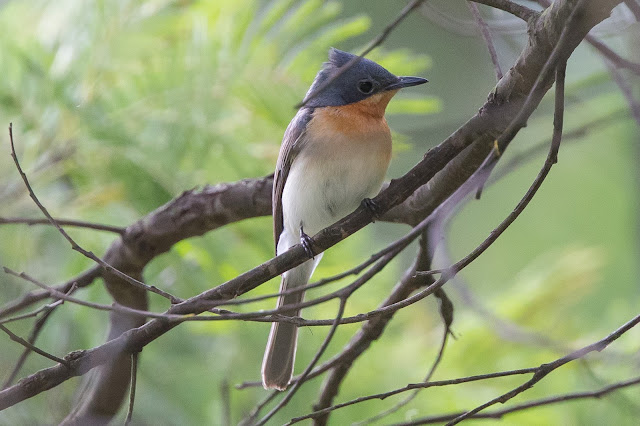First up and still in half light were Rainbow Bee-eater and a pair of stunning Red-browed Finch feeding in the grasses. Our attention then was drawn to a large fruiting Eucalyptus where Black-chinned Honeyeater fed amongst the blossoms and then AD shouted ‘Regent Honeyeater’ and we were all quick to get onto two birds as they chased through the canopy before disappearing. A rather brief and distant view. We decided to get a little closer to the tree and head up the slope on which the tree was growing, as we climbed a bank a Wombat appeared and stood motionless before bolting into a tangle of branches of a fallen tree. As we approached VW and I wandered to where the animal had disappeared and suddenly the animal bolted towards us and down a nearby hole. The area was riddled with deep excavations and the area was evidently well used. We spent a while at the tree but had no further views of the honeyeater but Jacky Winter and White-throated Treecreeper were new. A further wander around the edge of the campsite produced fantastic Double-striped Finch, a flock of around 50 birds feeding along the woodland and grassland interface and then another pair (or the same) of Regent Honeyeater nesting in a pine alongside the campsite, the pair were busy nest building with one bird collecting material while the other flew back and forth accompanying the other bird and perching close by while the nest was woven. This pair were colour ringed and there is an intensive programme of conservation for this critically endangered species. We then headed onwards having great views of another Wombat on the roadside a short way on, this one stood motionless in the road before slowly wandering to its nearby hole. AD spotted a group of White-browed Babbler on the roadside so a quick stop gave good views of these cracking birds as they fed around an arboreal bundle of twigs. Then a Southern Shrike-thrush foraging on the woodland floor, a small group of 6 Little Lorikeet buzzed over and gave perched views in the top of a flowing tree and finally a cracking pair of Shrike-tit with chicks in a tree top nest avidly defending their nest from Noisy Friarbirds. These birds look like over blown Great Tits with hefty bills and wacky head dress raised while during the aggressive encounters with the friarbirds. The hefty bill being used to strip bark from trees in the hunt for food.
Galah - Capertee Valley
Eastern Rosella - Capertee Valley
Eastern Spinebill - Capertee National Park
Wombat - Capertee National Park
Double-barred Finch - Capertee National Park
Regent Honeyeater - Capertee National Park
Regent Honeyeater (juvenile) - Capertee National Park
Rainbow Bee-eater - Capertee National Park
Shrike-tit - Capertee Valley
Maned Duck - Capertee Valley
Fairy Martin- Capertee Valley
Welcome Swallow - Capertee Valley
It was 17:00 and time to head off for Sydney a drive of approximately three hours. We stopped en-route in Katoomba for diner and eventually arrived in Sydney at around 21:45, we checked into the Ibis Budget Hotel near to the airport and crashed in our prison cell like hotel room.
White-browed Babbler - Capertee Valley
Red-rumped Parakeet - Capertee Valley
Black-faced Cuckoo-shrike - Capertee Valley
Once considered to be part of the Richard's pipit complex Australasian Pipit
is now considered a separate species - Capertee Valley
White-throated Treecreeper - Capertee Valley
Brown Thornbill - Capertee Valley
Satin Flycatcher - Capertee Valley
Olive-backed Oriole - Capertee Valley
Superb Fairy-wren - Capertee Valley
Plum-headed Finch - Capertee Valley
Links to other days of the trip






















